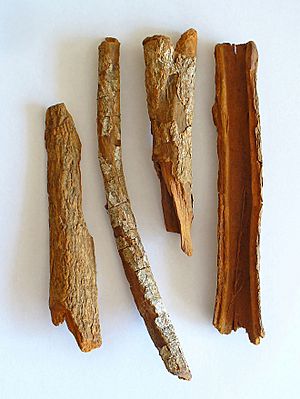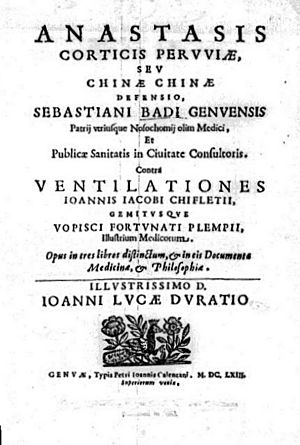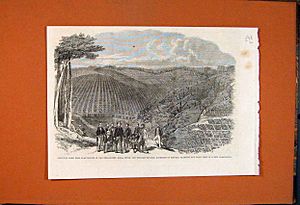Jesuit's bark facts for kids
Jesuit's bark is also called cinchona bark or Peruvian bark. It comes from the bark of the Cinchona tree. This tree grows naturally in the Andes mountains of South America. For a long time, this bark was a very important medicine. It helped treat malaria because it contains a substance called quinine. Jesuit missionaries in Peru learned about this traditional medicine in the 1600s.
Contents
History of Cinchona Bark
The story of cinchona bark in the Western world began over 350 years ago. Around 1650, a doctor named Sebastiano Bado said this bark was more valuable than all the gold and silver from South America. In the 1700s, an Italian professor, Bernardino Ramazzini, compared its importance in medicine to the discovery of gunpowder in war. Many people agreed with him.
Even Benjamin Franklin knew how important and debated Jesuit's bark was. He wrote about it in his Poor Richard's Almanack in 1749. He shared a story about how Robert Talbot used it to cure the French Dauphin. Hugh Algernon Weddell also noted that few things in nature had interested so many important people as cinchona.
However, there was a lot of disagreement about it. This was mainly because the Jesuits discovered it. Alexander von Humboldt said that some Protestant doctors disliked the Jesuits. This dislike caused a long argument about whether Peruvian Bark was good or harmful.
How the Bark Was Discovered
Spanish Jesuit missionaries in Peru learned about the bark's healing power from local people. This happened between 1620 and 1630. A Jesuit in Loxa was cured of malaria using the bark. This led to it being called "Loxa Bark."
In 1630, the bark was used to help the Countess of Chinchon. She was the wife of the new viceroy (a ruler representing the king). She had just arrived from Europe and became very ill with malaria in Lima. The countess was saved by the bark. To show her thanks, she had large amounts of it collected. She gave it to other malaria sufferers, sometimes herself, and sometimes through the Jesuits in Lima. This bark was then called pulvis comitissæ (Countess's powder).
The countess returned to Europe in 1640. She was the first to bring the bark there. She helped spread its use across Spain and other parts of Europe. The Jesuit Barnabé de Cobo also helped bring the bark to Europe. In 1632, he brought it from Lima to Spain, then to Rome and other parts of Italy. By 1640, Count Chinchon and his doctor, Juan de Vega, also brought it back with them.
Spreading the Word in Europe
Count Chinchon did not focus much on selling the bark. But the Jesuit Bartolomé Tafur brought a much larger amount to Europe. He traveled through France in 1643. There's a story that he cured the young Louis XIV, who was then the dauphin, using Peruvian bark. Tafur then continued to Italy and Rome.
The famous Jesuit theologian John de Lugo learned about cinchona from Tafur. De Lugo became a cardinal in 1643. From then until his death in 1660, he strongly supported the bark. He gave it away freely in Italy and other parts of Europe. Because of his efforts, the bark was sometimes called pulvis cardinalis or pulvis Lugonis. Many portraits were painted of him.
Cardinal de Lugo had the bark tested by the pope's doctor, Gabriele Fonseca. The doctor gave a very good report. The bark was only given to sick people in Rome with the approval of Roman doctors. The cardinal had more bark brought from America through trade routes in Spain.
Many other people who supported the bark were influenced by de Lugo. For example, Pietro Paolo Pucciarini, a Jesuit apothecary (someone who prepares and sells medicines) in Rome, helped a lot. He made sure the real, pure bark was given out. He is also credited with writing the earliest Roman instructions for using the bark, dating from 1651.
Defending the Bark
De Lugo's friend, Honoré Fabri, a French Jesuit, helped defend the bark. Fabri wrote the first paper on cinchona published in Italy in 1655. This paper argued against a doctor from Brussels, Jean-Jacques Chifflet, who had written against the bark. Fabri's paper was the first of many that defended its use.
Two men from Genoa, Girolamo Bardi (a priest) and Sebastiano Baldo (a doctor), were also early supporters. They were close with the cardinal. Baldo even included a letter from de Lugo in his main work. This letter, dated 1659, showed that the cardinal was still working to help spread cinchona even at 77 years old.
The Jesuits helped spread the bark from Rome across Europe. In 1646, 1650, and 1652, delegates from different Jesuit provinces returned home from general meetings. They took the bark with them. Soon, it was being used in Jesuit colleges in places like Genoa, Lyon, Leuven, and Ratisbon.
The remedy, known as "Jesuit's powder," quickly reached England. In 1658, the English newspaper Mercurius Politicus announced that the "excellent powder" could be bought from London chemists.
In the 1600s and 1700s, bark kept in Jesuit pharmacies was thought to be especially effective. This was because they could provide a genuine and pure supply. Jesuit missionaries also took the remedy to malaria-affected areas in other countries. They even reached the courts of Peking, China, and Kyoto, Japan. They cured the emperor of Japan using the bark. In Peru during the 1700s, they encouraged collectors to start new plantations. In the 1800s, they were the first to plant cinchona trees outside of South America.
See also
 In Spanish: Corteza de quina para niños
In Spanish: Corteza de quina para niños
- History of malaria
- Luis Jerónimo de Cabrera, 4th Count of Chinchón
- Schedula Romana
- Therapeutice Specialis
- Juan de Lugo





